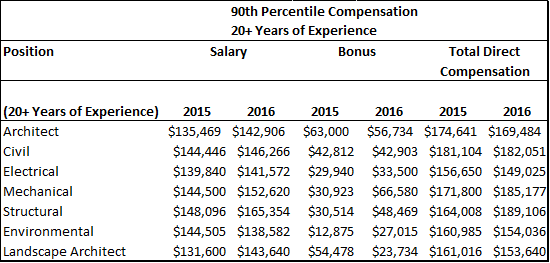 Even more than in previous years, firms leaders should not be satisfied with average performance either for themselves or their firm. Achieving high performance levels implies that goals are set at high levels.
Even more than in previous years, firms leaders should not be satisfied with average performance either for themselves or their firm. Achieving high performance levels implies that goals are set at high levels.
The table below from the PSMJ's 2016 A/E Staff Compensation Benchmark Survey Report indicates the salary, bonus, and total direct compensation achieved at the top 10% of participating firms (the 90th percentile of the survey data), for those individuals with 20+ Years of Experience. This means 10% of the individuals receive compensation at this level or higher.

High levels of compensation clearly demonstrate that a design firm can be operated at an economically rewarding level and individuals can receive significant levels of personal compensation.
To achieve these levels of compensation, design firms should consider the following types of management concepts:
-
Do whatever it takes to create a strong strategic plan for your firm. Define your firm’s key market differentiators that position it for success. Establish plans to correct or mitigate any shortcomings in your analysis.
-
Choose to do work only for quality clients. Search for projects with potentially high profits. Don’t just take what comes along or work for any client who sends you a request. Select the clients you want to work for, not the other way around.
-
Demonstrate the ability to walk away from projects or clients who do not pay a fair fee for the effort or risk required.
-
Demand strict adherence to project budgets, rewarding only performance that is better than expected, not just what meets expectations.
-
Make it obvious that you know how to attract, retain, and motivate staff members
who are clearly superior to their peers by establishing a clear Employer Brand. Remember that your actions speak louder than words.
-
Finally, motivate your staff through vision and leadership. Set goals to stretch your staff toward new heights, and reward them appropriately.
While the need to attract and retain high performing employees is at an all-time high, PSMJ consultants have found that reliable architecture/engineering industry compensation data based on years of experience is difficult to find. PSMJ's A/E Staff Compensation Benchmark Survey Report provides detailed compensation data for 48 professional staff & technical positions based simply on discipline and years of experience.
You also might be interested in these compensation-related blog posts:Trend Line: How Do A/E Firm Leaders Charge Their Time?
Data Dive: How Financial Performance Impacts Your Compensation Options
The War for Talent: Does Your Compensation Strategy Measure Up?
Trend Line: Larger Firm Equals Larger Compensation



